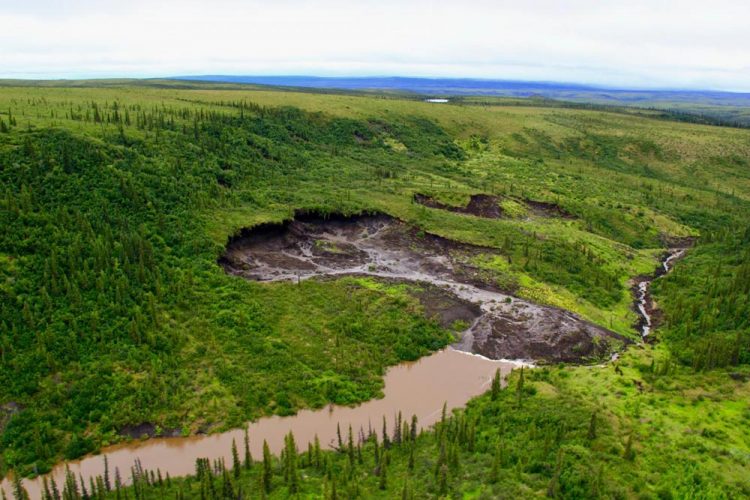Record levels of mercury released by thawing permafrost in Canadian Arctic

Methyl mercury is being released into environments such as this one, on the Peel Plateau in the Northwest Territories, Canada. Credit: Scott Zolkos
Permafrost thaw slumps in the western Canadian Arctic are releasing record amounts of mercury into waterways, according to new research by University of Alberta ecologists.
Mercury is a naturally occuring contaminant that is toxic to humans and other animals in large quantities as it accumulates in organisms and food webs. Sediments in permafrost are estimated to store more mercury than Earth's oceans, atmosphere, and soil combined. And, as climate change causes permafrost to thaw, the mercury stored in permafrost becomes available for release into the surrounding environment.
“Concentrations of mercury were elevated for at least 2.8 kilometres downstream of thaw slumps,” says Kyra St. Pierre, Vanier Scholar PhD student, who co-led the study with fellow graduate students Scott Zolkos and Sarah Shakil in the Department of Biological Sciences. “This suggests that some mercury from thaw slumps may be transported for many kilometres through downstream ecosystems, and into larger waterways.”
The issue is exacerbated by rising temperatures and increasing precipitation in the Canadian Arctic due to climate change.
“Climate change is inducing widespread permafrost thaw,” explained St. Pierre, who conducted the study under the supervision of Assistant Professor Suzanne Tank, and Professor Vincent St. Louis . “In regions where this results in thaw slumping, this may release a substantial amount of mercury into freshwater ecosystems across the Arctic.”
However, because the mercury is locked within sediments, the scientists are unsure as to whether this mercury could be consumed by organisms in the area and whether this mercury poses any threat to the security of northern food webs.
These results highlight the need for further research on mercury cycling in regions experiencing active permafrost thaw, as well as studies examining if and how this mercury might enter food webs in surrounding ecosystems.
The research was conducted in partnership between the University of Alberta and the Government of the Northwest Territories in response to Northwest Territories' community interests in the downstream effects of permafrost thaw.
###
The paper, “Unprecedented increases in total and methyl mercury concentrations downstream of retrogressive thaw slumps in the western Canadian Arctic,” was published in Environmental Science & Technology (doi: 10.1021/acs.est.8b05348).
Media Contact
All latest news from the category: Life Sciences and Chemistry
Articles and reports from the Life Sciences and chemistry area deal with applied and basic research into modern biology, chemistry and human medicine.
Valuable information can be found on a range of life sciences fields including bacteriology, biochemistry, bionics, bioinformatics, biophysics, biotechnology, genetics, geobotany, human biology, marine biology, microbiology, molecular biology, cellular biology, zoology, bioinorganic chemistry, microchemistry and environmental chemistry.
Newest articles

NASA: Mystery of life’s handedness deepens
The mystery of why life uses molecules with specific orientations has deepened with a NASA-funded discovery that RNA — a key molecule thought to have potentially held the instructions for…

What are the effects of historic lithium mining on water quality?
Study reveals low levels of common contaminants but high levels of other elements in waters associated with an abandoned lithium mine. Lithium ore and mining waste from a historic lithium…

Quantum-inspired design boosts efficiency of heat-to-electricity conversion
Rice engineers take unconventional route to improving thermophotovoltaic systems. Researchers at Rice University have found a new way to improve a key element of thermophotovoltaic (TPV) systems, which convert heat…



